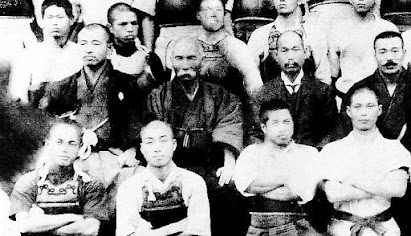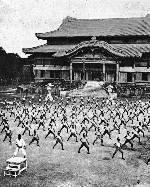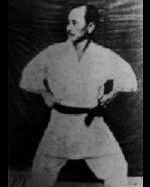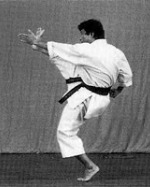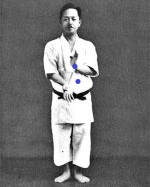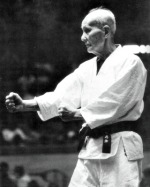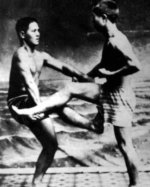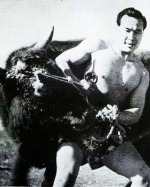The Life and Legends of Anko Itosu
Talk the Talk
The word Kata is used in several Japanese martial arts and refers to a sequence of specific basic movements that are used to train the mind and body of the participant.
When done correctly, absolute perfection of technique is the aim which while unattainable, encourages constant practice and focus.
Walk the Walk
When Anko Itosu was 75 years old, he was challenged to a fight by a student of Judo, who not only had home advantage but happened to be half his age.The karate master hit the judo champion once in the body with his left hand, rendering the judoka unable to breathe and collapsed on the floor.
Once Sensei Itosu had helped the Judo champion regain his breath, he bowed respectfully and left.
Karate Quote
"When you train, do so as if on the battlefield. Your eyes should glare, shoulders drop, and body harden.You should always train with intensity and spirit as if actually facing the enemy, and in this way, you will naturally be ready".
~ Anko Itosu ~
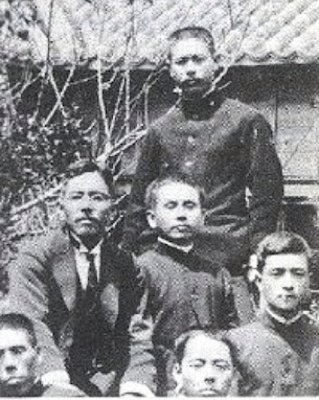
Anko Itosu’s teachings are legendary in world martial arts and along with his Master, Sokon ‘Bushi’ Matsumura, he was instrumental in the development of the Shuri-te style of Okinawan karate.
Itosu can be said to be the first person to practise what would closely resemble the type of Shotokan karate that is common today and was responsible for taking the martial art from being practised secretive and behind closed doors, to being spread to the general public in Okinawa.
The Early Life of Anko Itosu
Born in 1831 in the city of Shuri in Okinawa, Itosu is believed to have had a rough childhood, often being beaten and abused by his father who would tie him up and continually poke him with a stick in order to teach him fighting spirit. This would be reflected later in the teachings of Sensei Itosu, as many of the kata he is thought to have invented and influenced have moves that are designed to disarm a would-be attacker brandishing a stick.
At the age of sixteen, he started learning karate from Master Matsumura and by the time he grew up, Itosu was a well-educated man and worked as King Sho Tai’s personal secretary, whom he served for thirty years. For Itosu and the rest of the inhabitants of the island, everything changed in 1879 as the newly empowered Japanese emperor ended the Royal Dynasty of Okinawa, sending the king into exile. Most of the Okinawan martial arts masters had worked for the king so as a result of his fall from grace many, including Itosu, suddenly found themselves living in abject poverty even though they were of the higher social class.
Anko Itosu and his Legendary Fighting Prowess
When Anko Itosu was a young man, he built up a reputation by winning several fights and there are a number of legends about his endeavours that have been handed down to us from an oral tradition:
Tomoyose – One such story tells of how he challenged an obnoxious bully named Tomoyose who was criticizing the Shuri-te style, calling it parlour karate. Itosu was then attacked by Tomoyose’s gang but he quickly dispatched three of them using one knockout blow for each. Tomoyose then decided to attack himself and was also subdued in a similar fashion, being rendered unconscious in a short time.
Sensei Itosu and the Thief – Gichin Funakoshi referred to his teacher’s incredible ability to withstand blows, his vice-like grip and his amazing physical strength. Itosu was a well-built, strong man who conditioned his body to be able to give and take the hardest of blows. He insisted his students regularly use the makiwara board, a pad that is repeatedly struck to make the hands tougher and to prepare them for high-impact hits.
One story that illustrates this power tells of a thief who tried to break into the master’s house. When Itosu heard his wooden gate rattle, he went to investigate only to realise that on the other side was the thief trying to gain access. Itosu, so the legend goes, punched straight through the thick wooden gate, grasping the would-be thief by the arm and creating a gaping hole in the gate.
Anko Itosu’s Influence on Karate History
While it can often be difficult to know where the truth ends and myths and legends begin, both these stories illustrate why Anko Itosu’s teachings are so important to karate history. It was him through the Shuri-te that popularised and possibly brought in the concept of finishing an opponent off with one blow, which is often delivered when an opponent begins their opening attack or following a defensive move or block.
Previously karateka, much like kung fu practitioners, would attempt to overwhelm their opponents with less powerful rapid-fire techniques and use grappling moves or lighter strikes to vulnerable areas such as pressure points, the eyes or the groin. For this reason, the master’s karate is said to be the first that closely resembles what is practised in Shotokan karate today, leading many to see him as the grandfather of modern-day karate.
Another major contribution made by Sensei Anko Itosu was to take the art out of secrecy and get it taught in Okinawan schools. This would start a chain of events that would lead to traditional karate being popularized throughout the world and becoming one of the most practised martial arts there is.
Written by Andrew Griffiths – Last updated 05/06/2023. If you like
what you see, consider following the History of Fighting on social media.
Further Reading:
Clayton, B.D. 2004. Shotokan’s Secrets. Via Google Books. Available from:et&hl=en&redir_esc=y [Accessed 11 November, 2012].
Funakoshi, G. 1981. [New Edition]. Karate-do: My Way of Life. Kodansha America, Inc. Tokyo.
Martial Arts – A Way of Life. [Internet]. 2012. Rochester Institute of Technology. Available from: http://cias.rit.edu/~ses7192/Project2/masters.html [Accessed 11 November, 2012].
Master Yasutsune (Ankoh) Itosu (1830-1915). [Internet]. 2012. Shotokai Encyclopedia. Available from: http://www.shotokai.com/ingles/bios/itosu.html [Accessed 11 November, 2012].
The 10 Precepts of Anko Itosu. [Internet]. 2012. Physical Arts. Available from:
Funakoshi, G. 1981. [New Edition]. Karate-do: My Way of Life. Kodansha America, Inc. Tokyo.
Martial Arts – A Way of Life. [Internet]. 2012. Rochester Institute of Technology. Available from: http://cias.rit.edu/~ses7192/Project2/masters.html [Accessed 11 November, 2012].
Master Yasutsune (Ankoh) Itosu (1830-1915). [Internet]. 2012. Shotokai Encyclopedia. Available from: http://www.shotokai.com/ingles/bios/itosu.html [Accessed 11 November, 2012].
The 10 Precepts of Anko Itosu. [Internet]. 2012. Physical Arts. Available from:
http://www.physicalarts.com/knowledge/general-interest/281-the-10-precepts-of-anko-itosu [Accessed 11 November, 2012].
More Karate History
Karate History Home
The history of karate begins in Okinawa, where martial arts were influenced by both kung fu from China, and the Japanese samurai. After weapons were banned on the island, unarmed combat techniques were developed into a style of fighting recognisable as traditional karate, which was further developed after being taken to Japan in the early twentieth century by Gichin Funakoshi.
The history of karate begins in Okinawa, where martial arts were influenced by both kung fu from China, and the Japanese samurai. After weapons were banned on the island, unarmed combat techniques were developed into a style of fighting recognisable as traditional karate, which was further developed after being taken to Japan in the early twentieth century by Gichin Funakoshi.
The History of Okinawan Karate
A look at the history of Okinawan karate and how it developed from the seventeenth century. Okinawan martial arts had influences from both the Japanese samurai and Chinese kung fu, as well as techniques unique to the island itself which over the years blended and evolved into the traditional karate styles that are practiced all over the world today.
A look at the history of Okinawan karate and how it developed from the seventeenth century. Okinawan martial arts had influences from both the Japanese samurai and Chinese kung fu, as well as techniques unique to the island itself which over the years blended and evolved into the traditional karate styles that are practiced all over the world today.
Gichin Funakoshi - Father of
Modern Day Karate
Gichin Funakoshi was born in Okinawa in 1868 and is known as the father of modern-day karate due to the innovations he made to Okinawan martial arts when he took it to Japan and popularised it with the people there. Not only did he found Shotokan karate, but he was also instrumental in spreading karate across the world.
Gichin Funakoshi was born in Okinawa in 1868 and is known as the father of modern-day karate due to the innovations he made to Okinawan martial arts when he took it to Japan and popularised it with the people there. Not only did he found Shotokan karate, but he was also instrumental in spreading karate across the world.
The History of the Shotokan Kata – Part One
A look at the history of the more basic Shotokan kata, including their origins, development, interesting facts and scholastic debate. This list of kata histories includes, Kihon kata, the Heian kata, the Tekki group, Bassai Dai and Sho, Empi, Hangetsu, Kanku Sho and Dai, Jion, Ji’in and Jitte and includes video links to the relevant kata.
A look at the history of the more basic Shotokan kata, including their origins, development, interesting facts and scholastic debate. This list of kata histories includes, Kihon kata, the Heian kata, the Tekki group, Bassai Dai and Sho, Empi, Hangetsu, Kanku Sho and Dai, Jion, Ji’in and Jitte and includes video links to the relevant kata.
The History of the Shotokan Kata – Part Two
A look at the history of the more advanced Shotokan kata, including their origins, development, interesting facts and debated issues. This list of karate kata histories includes, Wankan, Gankaku, Meikyo, Chinte, Gojushiho Sho and Dai, Sochin, Nijushiho and Unsu, and includes video links to the relevant kata.
A look at the history of the more advanced Shotokan kata, including their origins, development, interesting facts and debated issues. This list of karate kata histories includes, Wankan, Gankaku, Meikyo, Chinte, Gojushiho Sho and Dai, Sochin, Nijushiho and Unsu, and includes video links to the relevant kata.
Kenwa Mabuni – Founder of Shito-Ryu Karate
Kenwa Mabuni started life as a sickly child but transformed himself into a strong warrior through the practice and dedication to the martial arts. Through his studies with
great karate masters such as Anko Itosu and Kanryo Higaonna, along with the kung fu master Woo Yin Gue, he was able to combine what he had learned and develop one of the four
major styles of traditional karate, Shito-Ryu.
Hironori Otsuka – Founder of Wado-Ryu Karate
Hironori Otsuka was a renowned master of jujitsu by the age of 28 before becoming a karate student under Gichin Funakoshi. He excelled and quickly rose through the ranks to become an assistant instructor, helping to develop training techniques in Shotokan karate. Later, Master Otsuka would brake away and form Wado-Ryu, one of the main four styles of traditional karate.
Hironori Otsuka was a renowned master of jujitsu by the age of 28 before becoming a karate student under Gichin Funakoshi. He excelled and quickly rose through the ranks to become an assistant instructor, helping to develop training techniques in Shotokan karate. Later, Master Otsuka would brake away and form Wado-Ryu, one of the main four styles of traditional karate.
The Real Mr Miyagi – Founder of Goju Ryu
Sensei Chojun Miyagi was an early karate master who studied martial arts in both China and his homeland, Okinawa. He earned his place in martial arts history when he used his knowledge to blend soft (or internal) with hard (or external) techniques to develop the style known as Goju-Ryu, which is considered one of the main four styles and is today widely practiced throughout the world techniques.
Sensei Chojun Miyagi was an early karate master who studied martial arts in both China and his homeland, Okinawa. He earned his place in martial arts history when he used his knowledge to blend soft (or internal) with hard (or external) techniques to develop the style known as Goju-Ryu, which is considered one of the main four styles and is today widely practiced throughout the world techniques.
Mas Oyama – Founder of Kyokushin Karate
Mas Oyama, founder of Kyokushin karate was one of the best karate masters of all time. He developed his body, mind and techniques through rigorous training and fought and won hundreds of full contact battles against fighters from many different martial arts styles. To test his skills further, he also went head to head with 52 bulls and was victorious in all, whether against man or beast.
Mas Oyama, founder of Kyokushin karate was one of the best karate masters of all time. He developed his body, mind and techniques through rigorous training and fought and won hundreds of full contact battles against fighters from many different martial arts styles. To test his skills further, he also went head to head with 52 bulls and was victorious in all, whether against man or beast.
The images on this site are believed to be in the public domain, however, if any mistakes have been made and your copyright or intellectual rights have been breeched, please contact andrew@articlesonhistory.com.

